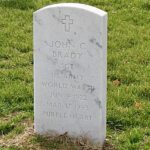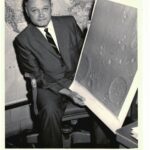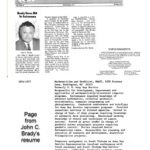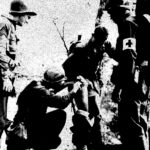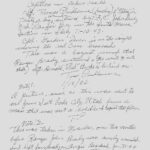Ranger John C Brady
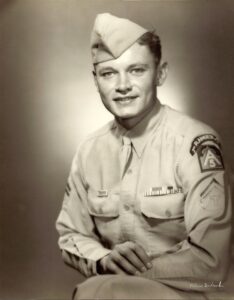
John Copsey Brady
Born: 9 June 1922 in Fairmont, West Virginia
Died: 17 March 1993 in Frederick, Maryland
Army Serial Number: 15377581
Ranger Battalion/Company: 1/B & 3/D
Rank: SGT
Enlisted: 10 December 1942 at Fort Hayes in Columbus, Ohio
Battles/Campaigns/Significants: Licata, Porto Empodocile, Messina in Sicily, Salerno, Chiunzi Pass, Venafro, San Pietro, Anzio and Cisterna in Italy
Medals/Awards: CIB, BSM, Good Conduct Medal, Purple Heart, EAME Campaign Medal, WWII Victory Medal, American Campaign Medal, Presidential Unit Citation(for Salerno, Chiunzi Pass), 2 Bronze Battle Stars and 1 Bronze Arrowhead
Biography
John Copsey Brady was born at home in Fairmont, West Virginia on 9 June 1922. He was the son of Alvey Pearre Brady and Naomi Lillian Stiffler. John grew up with two sisters Virginia & Emily. A sister, Edith Glenn Brady died of Whooping Cough in 1921 before he was born. He also had two brothers, Alvey Pearre Brady Jr. and William Elwood Brady. John was about age 3 when his older brother, Alvey Jr. died at the age of 7 in 1925.
John grew up in the town of Fairmont, West Virginia attending area grammar schools and several years in Elkins high school. The area was known for coal mining and John’s father, A.P. Brady was involved in the family business, Brady Coal Company which merged with 3 other coal mine companies and became known as Brady Coal Corporation. The merger made the Corporation the largest coal mining organization in the State of West Virginia. A.P. Brady was appointed Vice President of the corporation.
John filled out his draft card on 30 June 1942 in Stratford, Connecticut where he was working for Mr. Sikorsky. John’s physical description said he was 6 feet tall, weighted 158 pounds, blue eyes, blonde hair. John was inducted into military service at Fort Hayes in Columbus Ohio on 10 December 1942. John was at Fort Bragg in North Carolina according to his Ranger payroll roster. He would have been transported to a port in the US to be shipped overseas. The ship arrived in North Africa on 2 April 1942 and John started his foreign service. He was assigned to Company C of the 6th Battalion at the 1st Replacement Depot near Oran, Algeria. On 5 May 1943 John C Brady and 53 other enlisted men were transferred into the 1st Ranger Battalion for training. John was assigned to B Company of the 1st Ranger Battalion. By 3 June 1943, Ranger Brady was transferred for duty into D Company 3rd Ranger Battalion. Training was continued in Nemours, just outside of Oran, Algeria. The seasoned Rangers put the new trainees thru their paces with live machine gun fire, aquatic landing, speed marching, knife fighting and close combat. They were also trained up to the next position so they could move up in rank if needed.
Now there were three Ranger Battalions. The 3 Ranger Battalions would participate in “Operation Husky” which was the plan to drive the enemies out of the island of Sicily. Ranger Brady now in D Company 3rd Ranger Battalion was transported along with the entire 3rd Ranger Battalion on HMS Princess Astirid and HMS Princess Charlotte to within 3 miles off shore of Licata. The 3rd Rangers then boarded British “LCAs” in the early morning of 10 July 1943 and landed on the beach at Licata, Sicily. Dog Company under the command of Captain Alvah M. Miller were tasked to take out the enemy mortar positions on the high ground. By 3 PM of 10 July the 3rd Rangers had achieved all objectives. Ranger Brady had his first taste of battle. The 3rd Rangers continued to move across Sicily and drove the Germans from Porto Empodocile and Messina. The 3rd Rangers were put in reserve and eventually met up with the 1st and 4th Rangers who took Gela and Butera.
The 3rd Rangers were able to take a rest. In this time the men continued training, repairing or replacing equipment and bringing in replacement troops. The 3rd Rangers met up with the 1st and 4th Rangers in Corleone, Sicily. Meanwhile Operation Avalanche is in planning stages. All three Ranger Battalions participated in the landing at Maiori, Italy. The Rangers moved to Chiunzi Pass and surrounding areas to take out Germans trying to break thru the mountain pass. This operation lasted most of September 1943. All three Ranger Battalions were each awarded a Presidential Unit Citations for their brave actions.
After the actions at Salerno on 3 October, the Rangers were relieved of attachment to British 10 Corp. The same day all three Ranger Battalions were moved to a cliff-top Fascist boys’ camp at Castellammare, Italy. While the 3rd Rangers reorganized and trained the 1st and 4th Rangers started their mission on the Winterline in Venafro. This was very cold wet and snipers and mines were abundant. During this time on 10 November 1943 Ranger John Brady was injured by a bayonet and was treated by medic Tom Prudhomme of D Company. Brady was able to stay on duty. After about a month of training and receiving reinforcements on 30 November the 3rd Rangers joined in the fighting. They were in the area of San Pietro, and Monte Summacro range of mountains. They also experienced the bitter cold wet conditions. Many men had to be taken off the mountains with frost bite, trench foot and wounds. While Ranger John C. Brady was on the Winterline, he was promoted to T/5 on 6 December 1943. The 3rd Rangers were relieved of this duty on 14 December 1943. The soldiers would never forget the terrible fighting on the Winterline.
The 3rd Rangers would spend about a month to recover from the tough fighting and winter cold. There were poker games, dancing and drinking when men were off duty. They knew they would soon be in the fighting soon enough in Operation Shingle that was already in the planning stages. On 22 January 1944 the 1st and 4th Ranger Battalion came to shore at Anzio, Italy in the 1st wave. They were met with a small amount of resistance, according to COL Roy A. Murray. The 3rd Ranger Battalion made the Anzio Landing with the second wave. They were given the mission of finishing the task of cleaning the town of enemies and protecting the port facilities. As more specialized units moved in, the three Ranger battalions were told to prepare to move north.
On January 30 1944, T/5 John C. Brady would meet his most intense experience in combat. He participated in the fateful Battle of Cisterna. The 1st and 3rd Ranger Battalions’ mission was to move in on foot in the darkness of the evening 29 January with the task of infiltrating the town of Cisterna. The 4th Ranger Battalion was to move in with the 3rd battalion of the 15th Infantry Regiment to stage a major attack to drive the Germans out of the area. During the hours before this attack the Germans had secretly refortified their line and were anticipating the attack. They had amassed 71,000 soldiers, many of which were experienced in combat on the Eastern Front. Consequently, the 1st and 3rd Rangers were at a disadvantage. They would get trapped and surrounded without the 4th Rangers able to supply much needed ammo and reinforcements. Of the 767 men of the 1st and 3rd Rangers, 56 were killed, 53 were wounded, returned or escaped and approximately 658 were captured by the Germans. The 4th Rangers also had many casualties trying to break thru the heavily fortified enemy lines. On 30 January 1944 casualties for the 4th Ranger Battalion were 21 killed and 43 wounded.
During this period handfuls of Rangers were trying to make it back to the Allied lines. One story is about a handful of the 3rd Rangers. When the surrenders began Captain Larkin’s messenger, PFC Edward Kwasck, crawled under a destroyed German tank, where he found T/5 John C. Brady and another Ranger. The tracks of the tank had churned up earth under the vehicle, partially hiding the Rangers. The three men pushed up additional dirt to block the entrance from view. A German machine gun and later a mortar crew were positioned nearby. Brady had been wounded with shrapnel in his knee, but despite his pain, he kept silent. When darkest fell, Kwasck and the unidentified Ranger crawled out and took additional morphine and first-aid packets from the dead. They found a man still alive who had lost an ear and part of his jaw, 2nd Lt David L. Bennett of Dog 3, whom they carried back under the tank. Kwasck then went for water. Near the ditch, he heard a noise that turned out to be an American wire party from the 3rd Division that had turned the wrong way in the darkness. Kwasck told the sergeant in charge of their circumstance. The 3rd Division men went back to their unit and returned with an infantry patrol, medics and litters. The infantry captured the German machine-gun crew and the four Rangers were brought back to friendly lines.
T/5 John C. Brady spent many months recovering from his injuries and bouts of malaria in Army hospitals. He stayed in Europe at the 300th General Hospital that was located in Naples, Italy. On 21 April of 1944 per Special Order # 103 he was transported home on the hospital ship “Thistle.” John had a short stay at the Stark General Hospital in Charleston, South Carolina. On 10 May 1944 Special Order # 126 John was sent by train #3 to the Ashford General Hospital in West Virginia for additional treatment and observation.
T/5 John C. Brady was promoted to a Sergeant on 1 October 1945 at Army Service Forces at Headquarters Fort Benjamin Harrison in Indiana. He married Ruth G. Olesen on 1 May 1945 in Chester, Pennsylvania. They started a family and John worked while he attended Phoenixville Senior High School. He received his diploma at his graduate commencement ceremonies Friday morning on 14 June 1946. John had the desire to continue his studies and graduated from Fairmont State College. He started his Federal career at the US Postal Service is Fairmont, WV.
John relocated to the Washington, DC area for his new position at the Army Map Service in 1956. He did graduate work in mathematics at West Virginia University and the American University in Washington, D.C. Working at his full-time job. During his tenure there, the name of the agency changed to the U.S. Army Topographical Command and then to the Defense Mapping Agency. John worked in the Geosciences Division, Dept of Geodesy and Geophysics. John Brady also spent his evenings for five years at Georgetown University and was awarded with his Masters of Arts in Astronomy in 1971.
On 5 April 1963 John married Shirley M. MacDonald in Rockville, Maryland where they both lived. Combined they had 8 children. Shirley had also worked at the Army Topographic Command where John worked. Shirley later began an administrative career with Montgomery Co. Public School System.
John enjoyed hunting and fishing when he could find the time. He also enjoyed gardening and was passionate about genealogy. John had eight children and many grandchildren. John was also a member of the Ranger Battalions Association and attended some of the reunions. He died at age 70 on 17 March 1993 in Frederick, Maryland. He was buried with honors at Arlington National Cemetery in Arlington, Virginia. R.I.P. Sergeant John Copsey Brady.
